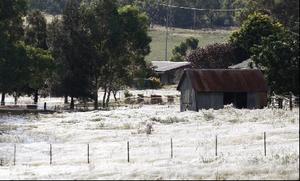DisastersNatural disasters have pushed Australia’s disaster insurance sky high
As natural disasters and superstorms become more frequent in Australia, the insurance rates for people who live and work in vulnerable areas have skyrocketed to the point where people may have no choice but to go uninsured.

Spider webs cover the ground following Australia's floods of 2012 // Source: alnashernews.com
As natural disasters and superstorms become more frequent in Australia, the insurance rates for people who live and work in vulnerable areas have skyrocketed to the point where people may have no choice but to go uninsured.
According to Allianz, one of the nation’s leading insurers, the average annual premium in Queensland, Australia is currently $8,200, but can be as high as $19,000. In New South Wales, the average is $4,704 and can reach as high as $24,000.
ABC Net reportsthat Australia has dealt with a series of brushfires and floods this year and as a result more than 65,000 claims have been filed. Insurance loses have been estimated at $674 million. Most of the losses have come in Queensland, where insurance claims from floods have reached the half-a-billion dollar mark.
Michael Sherris, a professor of actuarial studies at the University of New South Wales, said that insurance premiums will continue to rise due to the increasing rate of brushfires and flood disasters.
“A lot of these premium increases, apart from being driven by a better recognition of risk, they’re also driven to a large extent off the international reinsurance market,” Sherris told ABC Net. “When these insurers go to get their catastrophe coverage, they get increases in their reinsurance premiums because of international issues. And that’s going to happen again and that will mean some increase in premiums.”
Many home and business owners simply cannot afford the insurance hikes. The Natural Disaster Insurance Review(NDIR) has recommended a reinsurance program back by the government and Bill Shorten, the Minister for Workplace Relations, Financial Services and Superannuation, said the Australian government is “considering the idea” but there are some concerns as well.
“In some places, if people live in flood zones, whilst we want to see if the insurance companies are exploiting this, sometimes it’s not possible to just tell the market that you… if you live in a particularly risky area that we can ignore the risk,” Shorten says. “Having said that, we are working on it.”
Insurance companies are concerned that a government program would lead to market distortion. Nick Xenophon, an independent federal MP, wants a senate inquiry into a federal disaster program. Xenophon pointed to the U.S. disaster insurance program, but it is currently $18 billion in debt due to insurance claims from natural disasters, notably hurricanes Katrina and Sandy. According to Sherris, there are a number of other insurance programs in other countries that can be a model for Australia.
The NDIR has made efforts to reduce premiums with improved mitigations, but according to John Berrill, head of Maurice Blackburn’sinsurance litigation practice and also a panel member of the NDIR, there is still work to be done, because climate change is not going away anytime soon.
“Part of the government response to that has been to await the outcome of a climate change adaptation report, because they say that to assess the risk of what we can be up for, climate change is an important factor in that,” Berrill told ABC Net. “Now, my view is that that’s a reasonable response. It’s a big issue to be dealt with; I think the government is looking at it and, depending on the outcome of the election this year, the next government will have to deal with it. But it’s not going away.”
